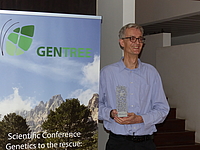
Domestication and breeding, for example of crop plants, inevitably results in a loss of genetic diversity as individuals with more favourable characteristics are selected. A new study by the GenTree project has shown that for forest trees, there has been almost no loss of diversity so far across several species at many sites.
Tree breeding remains in its infancy, largely because the long life of trees means that it can take decades to see improvements in subsequent generations. The time needed makes tree breeding expensive, which is why it has been limited to a few species of prime commercial importance. Nevertheless, the effects of selection have been noted after just one round of breeding, and other changes, including a loss of diversity, have been detected as a result of forest management.
For that reason, GenTree researchers set out to assess the levels of genetic diversity in natural and breeding populations (that is, seed orchards, clonal collections and populations under artificial selection) of eight tree species (Betula pendula, Picea abies, Pinus halepensis, Pinus nigra, Pinus pinaster, Pinus sylvestris and Populus nigra).
Loss of diversity can be of two kinds. Some genetic diversity is essentially neutral, meaning it does not confer any particular advantage or disadvantage on the individual. And some is functional diversity, of the kind that would be favoured or eliminated by natural or artificial selection. The researchers found no evidence of differences in either kind of diversity between the breeding populations and the natural populations from which the breeding material was obtained. In some of the breeding populations there were changes in alleles normally found at low frequencies, but this is to be expected as a result of the founder effect, which occurs because the breeding population starts with a small sample.
The researchers also compared the genetic diversity in the breeding populations with the diversity across the entire distribution range of the species, including populations in existing genetic conservation units. This comparison showed that natural populations represent a unique source of additional diversity that could be used to create new breeding populations or enrich existing ones. In this way, existing diversity can supply traits that will be useful under new climates expected in future, as well as for society’s future needs for goods and services from European forests.
Still to be completed is a comparison of differences between how breeding populations and natural populations might adapt to predicted climate changes. These investigations will provide breeders and forest managers with valuable insights for future selection efforts and management. The long lifespan of trees, however, means that further investigations will be needed in future to monitor long-term changes.
The full poster is available here.
Comparative analysis of genetic diversity in natural and breeding populations. Olsson S, Farsakoglou AM, Jorge V, Grivet D, Guerin V, Ojeda DI, Alía R*, Alizoti E, Aravanopoulos P, Bastien C., Cavers S, Fady B., González-Martinez S, Lascoux M, Pyhajärvi T, Scalabrin S, Tollesfrud MM., Vendramin G.G., Scotti I. 2020. Poster. GenTree Final Conference.


